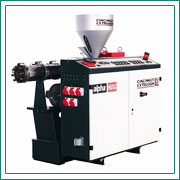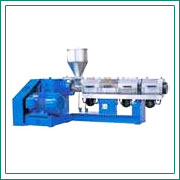Single Screw Extruder
Introduction
 Single screw extrusion is one of the main type of polymer processing operation. The principal function of a single screw extruder is to build up pressure in thepolymer melt so that the polymer can be extruded through the die. Most of the single screw extruders are plasticating which mean that the solid resin balls or powders melt in the screw due to the pressure. However, some single screw system can be used for mixing also. Single screw extruder is useful when pure polymer like HDPE is used. Single screw extrusion is one of the main type of polymer processing operation. The principal function of a single screw extruder is to build up pressure in thepolymer melt so that the polymer can be extruded through the die. Most of the single screw extruders are plasticating which mean that the solid resin balls or powders melt in the screw due to the pressure. However, some single screw system can be used for mixing also. Single screw extruder is useful when pure polymer like HDPE is used.
Extrusion Process: Single screw extruder basically consist of a screw, barrel, drive mechanism, resin feed arrangement and controls. The constantly turning screw moves the resin through the heated barrel where it is heated to proper temperature and blended into a homogeneous melt. A turbulent back pressure is build up which pushes the melt out of the extruder in the shape of the die. The resin sometimes is not completely melted in the basic extrusion screw. The barrier screw in designed to counter this problem. Sometimes, additional flights are attached to the transition section so as to separate molten and solid plastic to different channels. As the solid pellet moves forward it melts due to shear against the wall and thus melts and flows into the liquid channel. Thus the solid channel narrow gradually and the liquid channel widens.
The ability of a screw to manufacture products of good quality with high productivity and low cost is called its performance. At the design stage of an extrusion  process, evaluation of screw performance is very important. The deformation measure or stretching which materials undergo due to the regular flows inside a conventional screw channel increases linearly with the extruder channel length. process, evaluation of screw performance is very important. The deformation measure or stretching which materials undergo due to the regular flows inside a conventional screw channel increases linearly with the extruder channel length.
Extrusion screw design has been improving over the years, with new innovations and ideas. Nowadays, single screws are available that have a secondary flights that improve speed by enabling faster melting. Single screw extruder is available with different types of accessories like automatic gravimetric feeders, vent vacuum units, heat and pressure controllers, heat exchangers, melt pumps, static and dynamic mixers, microprocessor control systems, as well as with a wide range of screw geometries for different materials and products. |
|